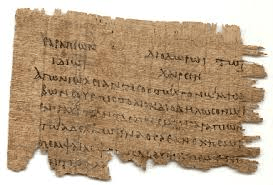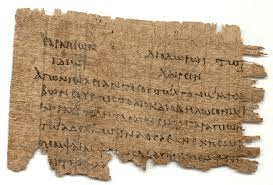Today, we’re diving into a fascinating piece of history captured in a papyrus fragment known as Trismegistos 463871. Dated between AD 685 and 705 and discovered in Hermopolis Magna, Egypt, this document is not just a relic; it’s a bilingual treasure, written in both Greek and Arabic. Translated by John V. Teixido (Yahya Muntasir Teixido Al-Andalus Abdullahi) using Perplexity AI, this fragment provides us with critical insights into the cultural, religious, and administrative transformations during the early Islamic period in Egypt.
Let's explore why this fragment is so significant and what it reveals about the world at that time.
Historical Context
The Transition to Islamic Rule
The Arab conquest of Egypt began in AD 639 under Amr ibn al-As, leading to a seismic shift in the region. Alexandria, once a beacon of Hellenistic culture and learning, fell into the hands of Islamic rulers. By the time our fragment was created, Egypt was already experiencing profound changes as Islamic governance began to take root. The bilingual nature of this document reflects the blending of cultures that characterized this era.
Hermopolis Magna
Hermopolis Magna was more than just a location; it was a vibrant urban center during both the Hellenistic and Roman periods. In the early Islamic era, it became a melting pot for diverse linguistic and cultural influences. The existence of a bilingual document from this region suggests that Hermopolis was a hub for interaction between different communities—an essential point for understanding how cultures adapt and evolve.
Analysis of the Fragment
Textual Content
The fragment opens with an invocation:
"[ἐν ὀνόμα]τ̣ι̣ τοῦ θ(εο)ῦ τοῦ ἐλεήμονος (καὶ) φ(ιλανθρώπου)"
"In the name of the God of mercy (and philanthropy)"
This sets a religious tone, indicating that this document may pertain to a formal declaration or request for divine assistance. Following this invocation, we see:
"οὐκ ἔστιν θ](εὸ)ς εἰ μὴ ὁ Θ̣(εὸ)ς"
"There is no god except the God"
This line emphasizes Islamic monotheism and highlights the religious shift occurring in Egypt at this time. The document continues with:
"[Μααμετ ἀπόστολος τὸῦ Θ̣(εο)ῦ]"
"[Muhammad, apostle of God]"
This acknowledgment of Muhammad as an apostle illustrates how Islamic beliefs were increasingly accepted within Egyptian society. Finally, we have:
"[Ἀβδελαζιζ υἱὸς Μαρουαν σύμβουλος]"
"[Abdelaziz son of Marwan, counselor]"
This line identifies an important political figure and suggests that the document may have legal or administrative implications.
Bilingual Nature
The bilingual format is particularly significant. By incorporating both Greek and Arabic, Trismegistos 463871 reflects the linguistic diversity present in Egypt during this transitional period. This coexistence highlights how different communities interacted and adapted to new political realities.
Cultural Implications
Religious Syncretism
This fragment exemplifies religious syncretism—the blending of different religious traditions. The invocation of God alongside references to Muhammad indicates a transition and acceptance of Islamic beliefs by the Christians within a single document. This phenomenon was common in regions experiencing significant cultural shifts and can be seen as a reflection of broader societal changes.
Administrative Evolution
The mention of Abdelaziz son of Marwan suggests that local governance was adapting to include Islamic leadership while still recognizing existing bureaucratic practices from previous administrations. This integration is crucial for understanding how Islamic authority was established in Egypt and how it coexisted with earlier traditions.
Modern Perspectives
Re-evaluating Historical Narratives
Trismegistos 463871 challenges modern historians to reconsider established narratives about cultural identity and continuity in Egypt. The fragment illustrates that cultural and religious identities are dynamic processes shaped by various influences, including conquest and social interactions.
Implications for Interfaith Relations
The coexistence of Greek and Arabic within this document serves as a reminder of the potential for interfaith dialogue and cooperation. Understanding how these cultures interacted can provide valuable lessons for contemporary discussions about multiculturalism and coexistence in today’s global society.
Conclusion
Trismegistos 463871 is more than just a historical artifact; it’s a window into a transformative period in Egyptian history. Its bilingual nature, religious content, and administrative references provide valuable insights into the cultural interactions that shaped early Islamic governance in Egypt.
Translated by John V. Teixido (Yahya Muntasir Teixido Al-Andalus Abdullahi) using Perplexity AI, this fragment serves as an essential resource for scholars seeking to understand the complexities of identity, culture, and religion during a pivotal moment in history. As we continue to explore such documents, we gain a deeper appreciation for the rich tapestry of human experience that defines our past and informs our present.
This article is to help you capture the significance of Trismegistos 463871 while reflecting on its broader implications for understanding cultural transitions during early Islamic rule in Egypt.
Sources
Papyri.info. (n.d.). Trismegistos: 463871. Retrieved January 7, 2025, from https://papyri.info/ddbdp/cpr;3;4?rows=3&start=13&fl=id,title&fq=has_transcription:true&fq=facet_language:grc&fq=unknown_date_flag:true&sort=series+asc,volume+asc,item+asc&p=14&t=741
Reading List 📖
"The Oxford Handbook of Papyrology" by Roger S. Bagnall
"The Ancient Egyptian Book of the Dead: The Book of Going Forth by Day" by Raymond Faulkner
"The Cambridge History of Ancient Greece" by Paul Cartledge






